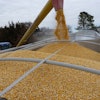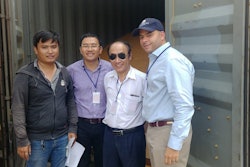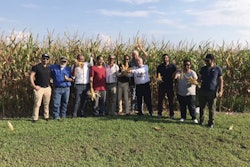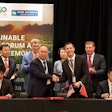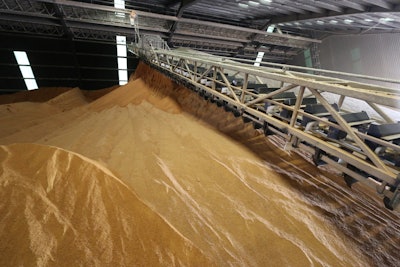
With five months of data released by the U.S. Department of Agr iculture (USDA), exports of U.S. distiller’s dried grains with solubles (DDGS) have stayed steady in the 2017/2018 marketing year that began last September.
The diversification of DDGS buyers and an increase in market share by longtime trading partners continues to support the expansion of the world market for this valuable and economical feed ingredient. The U.S. Grains Council (USGC) is continuing to support increased use of DDGS with programs designed to provide nutritional information to livestock producers in growing poultry, dairy and beef sectors in markets across the globe.
FTA partners equal top customers
Free trade agreement (FTA) partners purchased half of all exports of feed grains in all forms (GIAF) in 2016/2017, according to USDA trade data and USGC analysis. DDGS exports to the 20 U.S. FTA partner countries set a record during this time, even when two of the world’s largest historic buyers — China and Vietnam — temporarily stopped purchasing from the United States. Despite these disruptions, the United States exported 4.72 million tons of DDGS to FTA countries in 2016/2017, a 16% increase year-over-year. Thus far in 2017/2018, the United States has sold 2.02 million tons of DDGS to FTA partners.
A nearby example of the power of FTAs to set the stage for strong DDGS sales is the North American Free Trade Agreement (NAFTA), which has spurred significant growth in the Mexican feed and livestock sectors as well as deep integration of the U.S. and Mexican export and feed milling systems.
Since NAFTA entered into force, exports of U.S. DDGS to Mexico have increased 17-fold. Mexico is now the top buyer of U.S. DDGS, with sales of 912,000 tons thus far in 2017/2018, a 16% increase year-over-year. Canada is also increasing purchasing of U.S. DDGS, ranking as the eighth largest market thus far in the marketing year with 276,000 tons sold, an 18% increase year-over-year.
Additionally, the U.S.-Korea Free Trade Agreement (KORUS) has strengthened a longstanding and positive relationship with this top importer. Ninety-six percent of feed millers in South Korea now include DDGS in their rations for the country’s livestock and poultry industries, thanks in part to work started by the USGC in 2004 to introduce this feed ingredient. Now the USGC is working to increase inclusion rates for U.S. DDGS by continuing technical work with the nations’ feed manufacturers, which would provide additional opportunities for increased exports.
As the third largest buyer of U.S. DDGS in 2016/2017 at 980,000 tons, South Korea set a new record for imports, which the country has done every year since 2010/2011. Thus far in 2017/2018, South Korea is the second largest buyer of U.S. DDGS at nearly 456,000 tons, a slight increase year-over-year.
Collectively, these 20 markets with which the United States has FTAs, represent approximately 10% of global domestic product (GDP) and 43.3% of 2017/18 DDGS sales. Negotiating additional trade agreements with countries accounting for a larger share of total GDP and securing trade policy preferences with countries that show potential for increased feed grain demand is a critical part of the Council’s efforts to expand exports.
Monitoring demand potential in Southeast Asia
Though sales of DDGS to Vietnam were stymied in 2016/2017, the market in Southeast Asia as a whole remained strong and diversified to include 54 countries.
Following the detection of quarantine pests, the Vietnamese Plant Protection Department (PPD) issued a decision in October 2016 to temporarily suspend DDGS importation. As a result, Vietnam purchased 50% less U.S. DDGS in 2016/2017 at nearly 495,000 tons, compared to almost 986,000 tons the year prior.
The Vietnamese government lifted its suspension of U.S. DDGS imports in September 2017, following an intense effort by the USGC, the U.S. Department of Agriculture’s Animal and Plant Health Inspection Service (APHIS) and the Office of the U.S. Trade Representative (USTR). Thus far in the 2017/2018 marketing year, Vietnam has purchased 364,000 tons of U.S. DDGS, ranking as the sixth largest market.
Elsewhere in the region, the USGC has continued to support the expansion of DDGS sales by providing technical expertise and support as well as connecting grain buyers and end-users with U.S. suppliers. Programs in Vietnam are targeting aquaculture and swine programs, whereas activities in Indonesia and Malaysia focus on boiler and layer sectors. In the Philippines, the USGC is providing information on storage and handling.
This work throughout the region is helping end-users determine how best to incorporate U.S. DDGS into their rations, and the USGC has seen notable increases in demand.
Thailand was the fourth largest buyer of U.S. DDGS in 2016/2017, purchasing 791,000 tons. Already in the new marketing year, Thailand has purchased 377,000 tons, bolstered by the Council’s trade servicing and technical assistance to the country’s feed manufacturers for swine, broilers and layers sectors, among the largest in the world. Indonesia has also steadily increased imports of U.S. DDGS over the three marketing years, importing about 512,000 tons in 2016/2017.
Indonesia has already purchased nearly 389,000 tons in the current marketing year, a 151% increase year-over-year that makes the country the fourth largest world buyer.
Smaller buyers are also substantially increasing their purchases of U.S. DDGS. New Zealand more than quadrupled purchases of U.S. DDGS with 151,000 tons in 2016/2017 and has already purchased nearly 99,000 tons in 2017/2018, a 52% increase year-over-year.
The USGC is also exploring future frontier markets in the region to capture even more demand potential. It conducted an on-the-ground assessment in 2017 of the growth potential for Myanmar’s animal and feed manufacturing sectors and how that growth could translate into increased exports of U.S. DDGS.
With a growth rate higher than neighboring countries, Vietnam and Thailand, Myanmar has the potential for strong growth in livestock production, particularly poultry and swine, over the next few years.
U.S. farmers and agribusinesses are already seeing Myanmar’s economic growth translate into imports of U.S. DDGS. Myanmar imported 35,700 metric tons of U.S. DDGS in 2016/2017, a 154% increase year-over-year. Thus far in the marketing year, Myanmar has purchased more than 20,000 tons of U.S. DDGS, a 17% increase from the same time the year prior.
Technical education, trade policy key to Middle East expansion
Imports of U.S. DDGS to the Middle East are also surging, a significant payoff for the Council’s marketing programs in countries like Turkey and Algeria.
The combination of competitive prices and the Council’s efforts to provide education on U.S. DDGS has been the key to market growth in Turkey.
The USGC has stayed active in the country through assessment missions, engaging the country’s six major feed grain importing companies and organizing regional seminars on quality to build confidence in marketing opportunities and connect end-users with U.S. suppliers.
As a result, Turkey was the second largest buyer of U.S. DDGS in the 2016/2017 marketing year with 1.29 million tons of imports, nearly double the total from the prior marketing year. Turkey is currently the third largest market in the new marketing year with 403,000 tons in DDGS purchases.
The poultry and dairy sectors in Algeria are also growing industries where U.S. co-products fit well into rations. However, a complex environment and government influence on the economy complicates market development efforts.
在过去的两年里,阿尔及利亚政府哈s imposed regulations and made decisions to restrict imports in order to offset the persistent drop in international oil and gas prices. That included a 17% value-added tax (VAT) on both U.S. DDGS and corn gluten feed (CGF). Combined with existing import duties of 30%, imports of these products were simply uncompetitive with other feed ingredients.
However, thanks to work by the USGC and partners in country to push for a reduction in tariffs, the Algerian government released a list of feed ingredients benefiting from an exoneration of a VAT until Dec. 31, 2018. The list notably includes corn, barley, DDGS and CGF, a particular success in this economical context.
While the exemption from the VAT is a success, U.S. DDGS and CGF are still subject to import duties of 30%, compared to 5% for both corn and soybean meal. As a result, the USGC will continue efforts to bring these import duties in line with other feed ingredients as well as to demonstrate the value of utilizing U.S. DDGS and CGF in poultry and dairy feed rations to Algerian producers.
Capitalizing on market opportunities in growing South Asian markets
The South Asian region is home to a large and growing population with an average economic growth much higher than the world average. The region continues to invest in the feed industry as meat consumption grows at a healthy pace, particularly poultry and aquaculture.
这些宏-economic factors offer significant potential for increasing demand. Combined with the region’s diminishing ability to produce feed grains locally, substantial export opportunities exist for coproduct exports like DDGS to the region.
More than 70 nutritionists, purchasing managers and other decision makers attended the South Asia Trade Exchange, jointly organized by the USGC and the U.S. Soybean Export Council (USSEC), in Colombo, Sri Lanka, in December 2017. Buyers learned why U.S. DDGS are valuable to their operations in addition to the Council’s commitment to provide services to help end-users confidently use the feed ingredient in their rations — a win-win situation for both U.S. farmers and suppliers as well as end-users.
由于贸易这等服务活动s conference and cost competitiveness, Bangladesh has more than doubled year-over-year imports of U.S. DDGS with 64,000 tons in purchases thus far in 2017/2018. Sri Lanka has nearly tripled U.S. DDGS exports year-over-year at 13,000 tons.
Optimistic market potential continues in 2017/2018
Market potential for DDGS exports across the globe remain optimistic in 2017/2018. The combination of one of the lowest per unit of protein cost compared to other feed ingredients in the market with the Council’s work helping end-users determine how best to incorporate U.S. DDGS into their rations leads the USGC to expect demand for U.S. DDGS continue to strengthen.
Underpinning this new demand potential is the need for continued access to these markets. The increase in market share by long-term partners and new customers continues to demonstrate how this critical component of trade opens the door for the Council’s market development work and turns opportunities into sales benefiting U.S. stakeholders throughout the marketing year.




